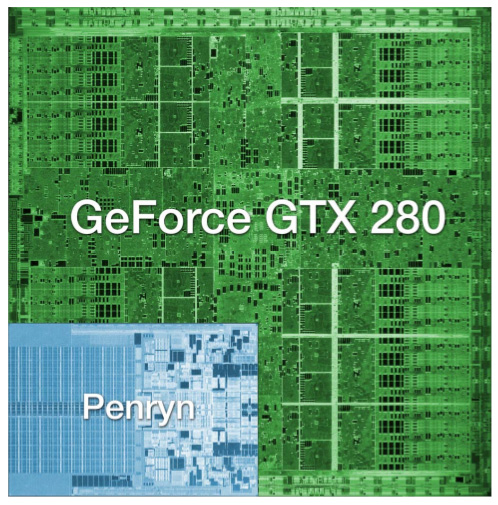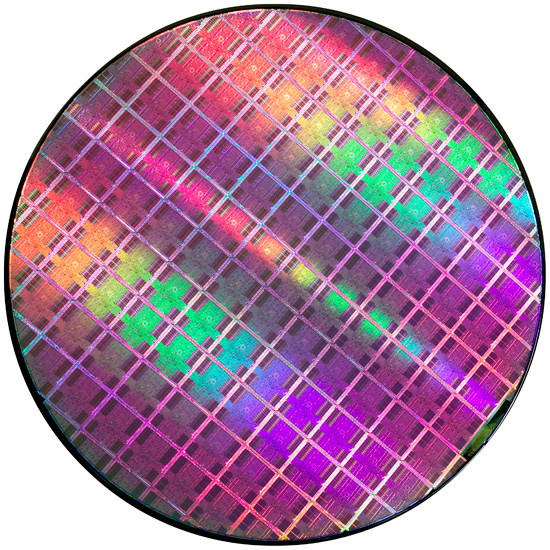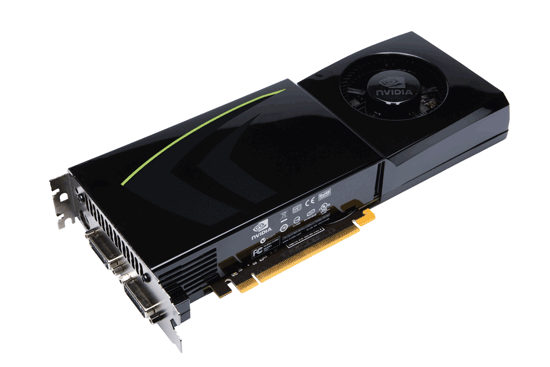NVIDIA's 1.4 Billion Transistor GPU: GT200 Arrives as the GeForce GTX 280 & 260
by Anand Lal Shimpi & Derek Wilson on June 16, 2008 9:00 AM EST- Posted in
- GPUs
One-Point-Four-Billion. That's transistors folks.
The chip is codenamed GT200 and it's the successor to NVIDIA's G80 and G92 families. Why the change in naming? The GT stands for "Graphics Tesla" and this is the second generation Graphics Tesla architecture, the first being the G80. The GT200 is launching today in two flavors, the die of the larger one is pictured below:

Um...yeah...we're reviewing that today
(this die comparison is to scale and that's a dual-core Penryn)
Let's put aside all the important considerations for a moment and bask in the glow of sheer geekdom. Intel's Montecito processor (their dual core Itanium 2) weighs in at over 1.7 billion transistors, but the vast majority of this is L3 cache (over 1.5 billion transistors for 24MB of on die memory). In contrast, the vast majority of the transistors on NVIDIA's GT200 chip are used for compute power. Whether or not NVIDIA has used these transistors well is certainly the most important consideration for consumers, but there's no reason we can't take a second to be in awe of the sheer magnitude of the hardware. This chip is packed full of logic and it is huge.

At most, 94 NVIDIA GT200 die can be produced on a single 300mm 65nm wafer from TSMC. On the other end of the spectrum, Intel can fit around 2500 45nm Atom processors on a 300mm wafer.
If the number of transistors wasn't enough to turn this thing into a dinner plate sized bit of hardware, the fact that it's fabbed on a 65nm process definitely puts it over the top. Current CPUs are at 45nm and NVIDIA's major competitor in the GPU market, AMD, has been building 55nm graphics chips for over 7 months now. With so many transistors, choosing not to shrink their manufacturing process doesn't seem to make much sense to us. Smaller fab processes offer not only the potential for faster, cooler chips, but also significantly reduce the cost of the GPU itself. Because manufacturing costs are (after ramping production) on a per wafer basis, the more dies that can be packed onto a single waffer, the less each die costs. It is likely that NVIDIA didn't want to risk any possible delays arising from manufacturing process changes on this cycle, but that seems like a risk that would have been worth taking in this case.
Instead, GT200 is the largest die TSMC has ever fabbed for production. Quite a dubious honor, and I wouldn't expect NVIDIA to really see this as something of which to be proud. Of course, that doesn't mean we can't be impressed with the sheer massiveness of the beast.
And what do we get from all these transistors? Moving up from 690M transistors of the original G80 and 754M transistors in G92 to the 1.4B transistors of GT200 is not a small tweak. One of the major new features is the ability to processes double precision floating point data in hardware (there are 30 64-bit FP units in GT200). The size of the register file for each SP array has been doubled. The promised ability of an SP to process a MAD and a MUL at the same time has been enhanced to work in more cases (G80 was supposedly able to do this, but the number of cases where it worked as advertised were extremely limited). And the number of SPs has increased from 128 on G80 to 240 with GT200. To better understand what all this means, we'll take a closer look at the differences between G80 and GT200, but first, the cards.
Clock Speeds, Pricing and HDMI Information
NVIDIA is introducing two GT200 parts today along with slightly tweaked branding. The new brand is called the GeForce GTX, and the first two cards are the GTX 280 and GTX 260.
Here's the card, say hello:

The GeForce GTX 280
It's got a little sibling too:

The GeForce GTX 260
The GeForce GTX 280 features 240 streaming processors running at 1.3GHz. It's got a 512-bit memory interface to 1GB of GDDR3 running at 2.2GHz (1107MHz core clock). The rest of the GPU runs at 602MHz.
| |
GTX 280 | GTX 260 | 9800 GX2 | 9800 GTX | 8800 GTS 512 | 8800 GT |
| Stream Processors | 240 | 192 | 256 | 128 | 128 | 112 |
| Texture Address / Filtering | 80 / 80 | 64 / 64 | 128 / 128 | 64 / 64 | 56 / 56 | 56 / 56 |
| ROPs | 32 | 28 | 32 | 16 | 16 | 16 |
| Core Clock | 602MHz | 576MHz | 600MHz | 675MHz | 650MHz | 600MHz |
| Shader Clock | 1296MHz | 1242MHz | 1500MHz | 1690MHz | 1625MHz | 1500MHz |
| Memory Clock | 1107MHz | 999MHz | 1000MHz | 1100MHz | 970MHz | 900MHz |
| Memory Bus Width | 512-bit | 448-bit | 256-bit x 2 | 256-bit | 256-bit | 256-bit |
| Frame Buffer | 1GB | 896MB | 1GB | 512MB | 512MB | 512MB |
| Transistor Count | 1.4B | 1.4B | 1.5B | 754M | 754M | 754M |
| Manufacturing Process | TSMC 65nm | TSMC 65nm | TSMC 65nm | TSMC 65nm | TSMC 65nm | TSMC 65nm |
| Price Point | $650 | $400 | $500 | $300 | $280 | $170-$230 |
You'll need a power supply that can deliver up to 236W for the card itself and you'll need both a 6-pin and an 8-pin PCIe power connector (the board won't work with two 6-pin connectors).
The GeForce GTX 280 will retail for $650 with availability planned for June 17th.
The GTX 260 brings the total core count down to 192 by disabling two Texture/Processing Clusters on the GPU (but still maintaining more cores than any single-GPU G80/G92 based card). The SPs run slightly slower on the GTX 260 (1242MHz vs. 1296MHz, NVIDIA uses a 27MHz crystal so that's why we get these funny clock frequencies), while the memory runs at approximately 2GHz (999MHz memory clock, 1998MHz data rate). The GTX 260 also loses one of the 8 64-bit memory controllers, bringing the total memory bus down to 448-bits and total memory size down to 896MB.
The GTX 260 consumes a maximum of 183W and only needs two 6-pin power connectors. The GeForce GTX 260 will set you back $400 and should be available on June 26th.

The GTX 280's shroud, though it takes some cues from the 9800 GX2, is better engineered to allow for heat expulsion through a larger vent next to the IO ports. The 9800 GX2 didn't have a very wide opening to the outside world from which to remove heat. This resulted in the 9800 GX2 disproportionately increasing the heat of the system. Since we run our systems without cases we don't see problems like this as soon as our readers do, and we would like to thank you for pointing this out to us.
Both the GTX 260 and 280 have two dual-link DVI outputs, which can be converted to HDMI using an adapter if you'd like. You can pass SPDIF using a connector at the top of the card, which will then be passed to the HDMI output when using the DVI-HDMI adapter. For the HTPC enthusiasts out there, the GTX 280 and 260 can output the following audio formats over HDMI:
2-channel LPCM
6-channel DD bitstream
6-channel DTS bitstream
Unfortunately there's no support for 8-channel LPCM or bitstreaming of Dolby TrueHD or DTS HD-MA.
















108 Comments
View All Comments
strikeback03 - Tuesday, June 17, 2008 - link
So are you blaming nvidia for games that require powerful hardware, or just for enabling developers to write those games by making powerful hardware?InquiryZ - Monday, June 16, 2008 - link
Was AC tested with or without the patch? (the patch removes a lot of performance on the ATi cards..)DerekWilson - Monday, June 16, 2008 - link
the patch only affects performance with aa enabled.since the game only allows aa at up to 1680x1050, we tested without aa.
we also tested with the patch installed.
PrinceGaz - Monday, June 16, 2008 - link
nVidia say they're not saying exactly what GT200 can and cannot do to prevent AMD bribing game developers to use DX10.1 features GT200 does not support, but you mention that"It's useful to point out that, in spite of the fact that NVIDIA doesn't support DX10.1 and DX10 offers no caps bits, NVIDIA does enable developers to query their driver on support for a feature. This is how they can support multisample readback and any other DX10.1 feature that they chose to expose in this manner."
Now whilst it is driver dependent and additional features could be enabled (or disabled) in later drivers, it seems to me that all AMD or anyone else would have to do is go through the whole list of DX10.1 features and query the driver about each one. Voila- an accurate list of what is and isn't supported, at least with that driver.
DerekWilson - Monday, June 16, 2008 - link
the problem is that they don't expose all the features they are capable of supporting. they won't mind if AMD gets some devs on board with something that they don't currently support but that they can enable support for if they need to.what they don't want is for AMD to find out what they are incapable of supporting in any reasonable way. they don't want AMD to know what they won't be able to expose via the driver to developers.
knowing what they already expose to devs is one thing, but knowing what the hardware can actually do is not something nvidia is interested in shareing.
emboss - Monday, June 16, 2008 - link
Well, yes and no. The G80 is capable of more than what is implemented in the driver, and also some of the implemented driver features are actually not natively implemented in the hardware. I assume the GT200 is the same. They only implement the bits that are actually being used, and emulate the operations that are not natively supported. If a game comes along that needs a particular feature, and the game is high-profile enough for NV to care, NV will implement it in the driver (either in hardware if it is capable of it, or emulated if it's not).What they don't want to say is what the hardware is actually capable of. Of course, ATI can still get a reasonably good idea by looking at the pattern of performance anomalies and deducing which operations are emulated, so it's still just stupid paranoia that hurts developers.
B3an - Monday, June 16, 2008 - link
@ Derek - I'd really appreciate this if you could reply...Games are tested at 2560x1600 in these benchmarks with the 9800GX2, and some games are even playable.
Now when i do this with my GX2 at this res, a lot of the time even the menu screen is a slide show (often under 10FPS). Epecially if any AA is enabled. Some games that do this are Crysis, GRID, UT3, Mass Effect, ET:QW... with older games it does not happen, only newer stuff with higher res textures.
This never happened on my 8800GTX to the same extent. So i put it down to the GX2 not having enough memory bandwidth and enough usable VRAM for such high resolution.
So could you explain how the GX2 is getting 64FPS @ 2560x1600 with 4x AA with ET:Quake Wars? Aswell as other games at that res + AA.
DerekWilson - Monday, June 16, 2008 - link
i really haven't noticed the same issue with menu screens ... except in black and white 2 ... that one sucked and i remember complaining about it.to be fair i haven't tested this with mass effect, grid, or ut3.
as for menu screens, they tend to be less memory intensive than the game itself. i'm really not sure why it happens when it does, but it does suck.
i'll ask around and see if i can get an explaination of this problem and if i can i'll write about why and when it will happen.
thanks,
Derek
larson0699 - Monday, June 16, 2008 - link
"Massiveness" and "aggressiveness"?I know the article is aimed to hit as hard as the product it's introducing us to, but put a little English into your English.
"Mass" and "aggression".
FWIW, the GTX's numbers are unreal. I can appreciate the power-saving capabilities during lesser load, but I agree, GT200 should've been 55nm. (6pin+8pin? There's a motherboard under that SLI setup??)
jobrien2001 - Monday, June 16, 2008 - link
Seems Nvidia finally dropped the ball.-Power consumption and the price tag are really bad.
-Performance isnt as expected.
-Huge Die
Im gonna wait for a die shrink or buy an ATI. The 4870 with ddr5 seems promising from the early benchmarks... and for $350? who in their right mind wouldnt buy one.